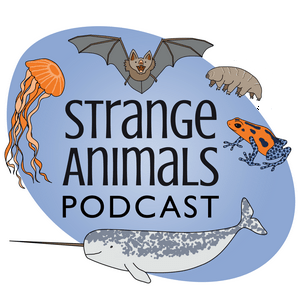Episode 433: Flamingos and Two Weird Friends
Thanks to Ryder, Alexandria, and Simon for their suggestions this week! Let's learn about three remarkable wading birds. Two of them are pink!
Bird sounds taken from the excellent website xeno-canto.
The goliath heron is as tall as people [picture by Steve Garvie from Dunfermline, Fife, Scotland - Goliath Heron (Ardea goliath), CC BY-SA 2.0, https://commons.wikimedia.org/w/index.php?curid=12223810]:
The roseate spoonbill has a bill shaped like a spoon, you may notice [picture by Photo Dante - Own work, CC BY-SA 4.0, https://commons.wikimedia.org/w/index.php?curid=42301356]:
Flamingos really do look like those lawn ornaments [picture by Valdiney Pimenta - Flamingos, CC BY 2.0, https://commons.wikimedia.org/w/index.php?curid=6233369]:
Show transcript:
Welcome to Strange Animals Podcast. I’m your host, Kate Shaw.
This week we’re going to learn about three large birds with long legs that spend a lot of time wading through shallow water, suggested by Ryder, Alexandria, and Simon.
Wading birds tend to share traits even if they’re not closely related, because of convergent evolution. In order to wade in water deep enough to find food, a wading bird needs long legs. Then it also needs a long neck so it can reach its food more easily. A long beak helps to grab small animals too. Having big feet with long toes also helps it keep its footing in soft mud.
Let’s start with Ryder’s suggestion, the goliath heron. It’s the biggest heron alive today, standing up to 5 feet tall, or 1.5 meters. That’s as tall as a person! It only weighs about 11 lbs at most, though, or 5 kg, but its wingspan is over 7 ½ feet across, or 2.3 meters. It’s a big, elegant bird with a mostly gray and brown body, but a chestnut brown head and neck with black and white streaks on its throat and chest.
The goliath heron lives throughout much of sub-Saharan Africa, meaning south of the Sahara Desert, anywhere it can find water. It’s happy on the edge of a lake or river, in a swamp or other wetlands, around the edges of a water hole, or even along the coast of the ocean. It usually stands very still in the water, looking down. When a fish swims close enough, the heron stabs it with its bill, pulls it out of the water, and either holds it for a while until the bird is ready to swallow the fish, or sometimes it will even set the fish down on land or floating vegetation for a while. It’s not usually in a big hurry to swallow its meal. Sometimes that means other birds steal the fish, especially eagles and pelicans, but the goliath heron is so big and its beak is so sharp that most of the time, other birds and animals leave it alone.
The goliath heron will also eat frogs, lizards, and other small animals when it can, but it prefers nice big fish. It can catch much bigger fish than other wading birds, and eating big fish is naturally more energy efficient than eating small ones. If a goliath heron only catches two big fish a day, it’s had enough to eat without having to expend a lot of energy hunting.
This is what a goliath heron sounds like:
[goliath heron call]
Alexandria’s suggestion, the roseate spoonbill, is also a big wading bird, but it’s very different from the goliath heron. For one thing, it’s pink and white and has a long bill that’s flattened and spoon-shaped at the end. It’s only about half the size of a goliath heron, with a wingspan over 4 feet across, or 1.3 meters, and a height of about 2 ½ feet, or 80 cm. That’s still a big bird! It mostly lives in South America east of the Andes mountain range, but it’s also found in coastal areas in Central America up through the most southern parts of North America.
Unlike the goliath heron, which is solitary, the roseate spoonbill is social and spends time in small flocks as it hunts for food. It likes shallow coastal water, swamps, and other wetlands where it can find it preferred food. That isn’t fish, although it will eat little fish like minnows when it catches...
